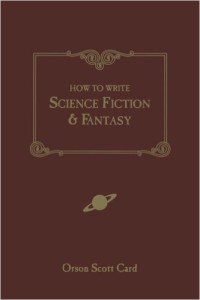 The first two chapters of this slim volume were most helpful to me. “What is science-fiction?” is not an easy question, especially in distinguishing it from fantasy and the broader category of speculative fiction. Basically, Card says sci-fi concerns experience that is not yet possible but is technologically or theoretically on the horizon, whereas fantasy is never going to happen (dragons, wizards, etc.). In Speculative fiction, the author proposes an idea or MacGuffin, and the story is the unfolding of all its ramifications.
The first two chapters of this slim volume were most helpful to me. “What is science-fiction?” is not an easy question, especially in distinguishing it from fantasy and the broader category of speculative fiction. Basically, Card says sci-fi concerns experience that is not yet possible but is technologically or theoretically on the horizon, whereas fantasy is never going to happen (dragons, wizards, etc.). In Speculative fiction, the author proposes an idea or MacGuffin, and the story is the unfolding of all its ramifications.
For example, in Card’s most famous novel, “Ender’s Game,” a military sci-fi story, Earth is about to be invaded by some aliens too tricky to beat so the brilliant strategy is to use a group of children who think they are playing a video game but are actually defending the planet. That’s the “conceit” or key idea of the speculative fiction. The rest of the story is about how that idea plays out.
Unfortunately, that description of speculative fiction is more a generalization than a definition of a genre. It excludes too little. Any good story should have a main “concept” such as the one described above, the basic “what-if” proposition of the novel. That’s true of fantasy, mystery, even romance novels. The category is only useful in allowing a space between hard sci-fi and traditional fantasy. Still, even this unresolved discussion was useful to me in clarifying marketing categories. I asked the owner of my local bookstore if she had a shelf for “speculative fiction,” and she said no. It’s either sci-fi or fantasy, and it’s often difficult to tell the difference.
The second chapter on “world creation” was fun because of a list of nearly all possible ways to achieve faster-than-light travel, from “Warp speed, Mr. Sulu,” to wormholes, and the list of possible ways to accomplish time travel. I was gratified to learn that my invention for FTL travel seems to be unique (as of 1990). I’ve never tried time travel.
The rest of the book uses sci-fi and fantasy examples but contains generic advice that any writer can benefit from, such as how to write character arcs, how to handle backstory, narrative exposition, and levels of diction. His useful MICE mnemonic stands for milieu, idea, character, and event – important structural elements of any story.
Unlike Stephen King, who is a seat-of-the-pants writer, Card insists that a good SF story requires a preliminary outline or story sketch. That’s the best way to achieve coherence, which is paramount in this story-driven genre, even if you end up deviating from the plan. I have to agree.
The last chapter is on how to market and sell your manuscript and how to improve your writing and your confidence with conferences, classes, and workshops. Much of that advice is dated. Hard to believe, but 1990 was pre-internet, so some of his recommendations are no longer germane. The book is indexed.
For ten bucks or less (used), it’s a worthwhile read just for the first two chapters. The middle two chapters, with general advice on good writing won’t hurt you. You can skip the last chapter.
Card, Orson Scott (1990). How to Write Science Fiction & Fantasy. Cincinnati, OH: Writer’s Digest Books (140 pp).
